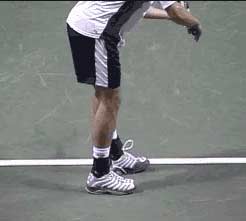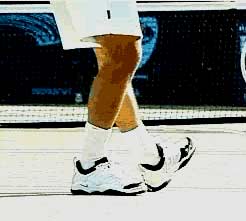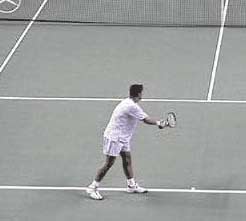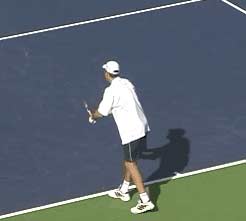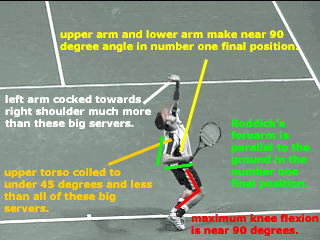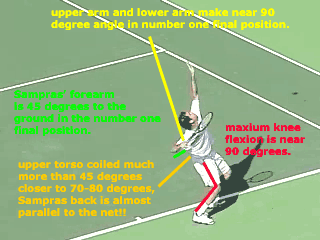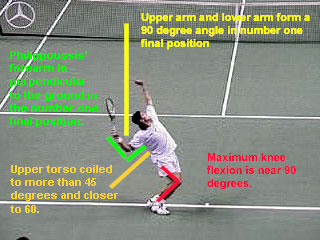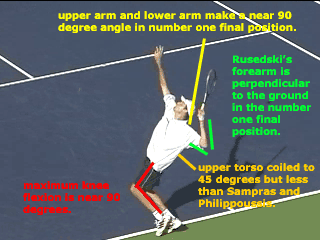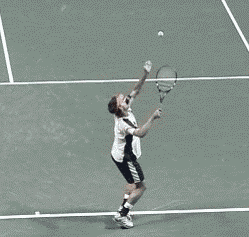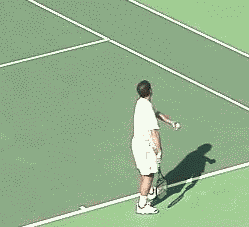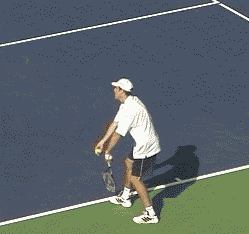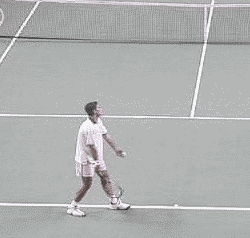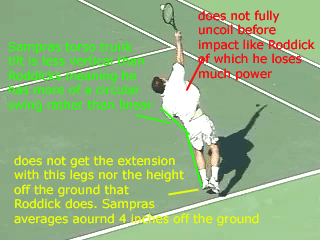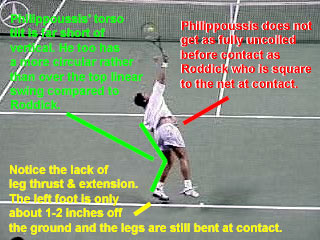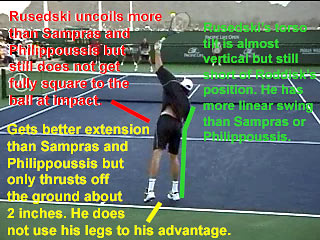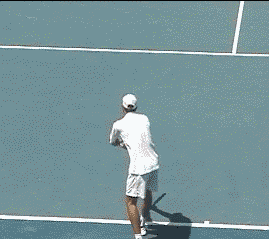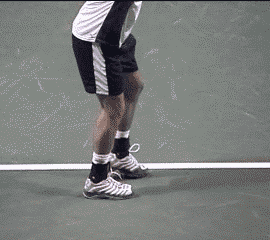|
TennisOne Lessons
Andy Roddick - The Bionic Serve How He Does it by Heath Waters 155 mph! That is the all time fastest serve record set by Andy Roddick in his Davis Cup performance against Belarus on September 27, 2004. Wow that is fast!
So, how does any human possibly hit a serve that fast? We will use science, biomechanics, and good old technique to deduce how Roddick achieves such phenomenal power. We will then break his serve down using the ACE system, compare his technique to the other fastest servers in the world, and show you the reference points that you can mimic to achieve a much more powerful serve yourself. To get the general idea the first thing let's use a bit of science and apply Newton's second law of motion, F=ma, into tennis terms and see how it relates to producing a more powerful serve. Since force is a synonym of power, and the goal here is to deduce how Roddick achieves all that power, then I will use this formula to demonstrate the logic in how you yourself can obtain a more powerful serve. Science declares that if I want to hit the serve with more power I must find a way to generate greater velocity through utilizing Newton's mass * acceleration formula. In tennis specific terms, I will presume mass=our body weight and acceleration=racquethead speed. So in order to acquire a more powerful serve I must first find a way to use my body weight more effectively when striking the ball or somehow increase the amount of body weight I put into the serve at the moment of impact. I must also find a way to generate more racquet speed or somehow get the racquet going faster through impact than I currently do now. My goal here is to increase mass and acceleration into impact so that I am generating more force upon the ball, which in turn equals more power. Roddick, as you will see in this article, has figured out by chance or by natural means how to utilize this concept better than anyone in history to date. A study during the 2000 Olympics on tennis servers by the American Sports Medicine Institute published in November 2003 gives us a brief scientific explanation of some of the biomechanical differences in lower velocity serves and higher velocity serves and scientifically points out some of the key attributes of both.
So lets put this all this into layman's terms and then break it down.
Bottom line is that for any player to achieve a more powerful serve they need to develop the proper mechanics along with increasing core strength (abs, hip flexors, lower back etc.) and leg strength. I will use the ACE system to examine some of the most powerful servers in the world, break their fundamental commonalities down into a 1, 2, 3 step easy to learn system, and then show you how to apply these fundamental commonalities to your own game so that you can increase your serving power beyond what you thought was possible. I will also explain why Roddick is the only player who consistently hits the ball over 140mph and why others only do it once in a while. So let's get started.
The Stance The first thing you will notice when observing Andy is that his starting stance is narrower than the other big servers and, like Sampras, he does not slide the back foot up. Although the stances of Rusedski and Philippoussis look very different than Roddick's in the beginning, once they slide their back foot up into their knee bend position the stances become very similar. So ultimately, it does not matter whether you slide your back foot up on the serve or not as long as you end up in the proper stance you see Roddick in.
Let's take a look at what does matter though and learn from the fundamental commonalities of these big servers. Number One - Preparation In the photos on the right I have illustrated the key fundamental reference points in position "number one," the preparation phase of the serve. As you see there are slight differences in the forearm position, upper torso coil, feet, and tossing arm position that we will discuss, but many key commonalities exist that we can learn from. These positions are imperative to achieve when executing a powerful serve. Whether you use a full swinging service motion like Sampras, Philippoussis, and Rusedski, or an abbreviated motion like Roddick, if these specific fundamental positions are achieved then you too will reach your power potential on your serve. The first reference point in what I will call position "number one," the preparation phase, is knee flexion. When going into the number one position, the knees should reach a maximum flexion of between 70-90 degrees. It is important to note that too much knee bend will inhibit your upward springing action with the legs into impact, so make sure not to go more than 90 degrees on your knee bend. As you can see here Roddick bends his knees ever so slightly more than the rest of the servers but not much. It is important to achieve this knee bend but more importantly is how one comes out of the knee bend that matters. The second reference point in the preparation phase is the position of the racquet hand forearm. This is where all the players are somewhat different and yet another secret and reason number one why Roddick consistently achieves more power than the rest. As you can see from the photos, Rusedski and Philippoussis' racquet hand forearms are perpendicular to the ground at maximum knee flexion or in the final preparation position "number one." Sampras is about 45 degrees to the ground and Roddick's forearm is parallel to the ground. All 4 players use a delayed racquet motion meaning the racquet moves more slowly than the toss hand into the final preparation position with Philippoussis using the least amount of delay and Roddick using the most even though he uses an abbreviated motion. This means Roddick will have the highest upper torso angular velocity when approaching impact and that in turn means he will be able to generate more racquet speed than the others. Rusedski, Sampras, and Philippoussis go straight to the cocked position (known to many as the scratch back position) when the upper arm and lower arm form 90 degrees and all three are in the scratch back position much longer than Mr. Roddick.
Roddick gets to this same position but holds the 90 degree position with his forearm parallel to the ground and his racquet pointing in front of him and not straight up to the sky as the other gentlemen. He then will make a double cocking action right before he begins his swing towards impact into "number two." This is reason number two why Roddick consistently obtains more power than the other servers. I really think he has discovered something here worth experimenting with. By using this motion he gets more of the slingshot or whip-like action that enables him to generate more racquet speed than the others. Observe below: The third reference point in the "number one" position to note is the upper torso coil. All four servers coil to different degrees with Sampras coiling the most and Roddick coiling the least. As you can see, Sampras' back is almost parallel to the net in his final preparation. On the other hand Roddick gets his back to about 45 degrees to the net or less so he is straighter on to the net than the other servers. It is important to get a good coil with the hips, legs, and torso, as this is instrumental in utilizing the kinetic chain and unleashing the kinetic energy (kinetic energy is the energy of movement) into impact. However, I think the amount of coil Roddick uses is much more efficient than the other servers and much easier for him to uncoil and release all the stored kinetic energy from the coiling action of the body. This is also reason number three why Roddick consistently serves harder than anyone in the world. He coils his upper torso but only enough to engage the kinetic chain. Remember it is not how much one coils but how they uncoil the body that matters! When one coils so much such as Mcenroe or Sampras, this tends to cause a more circular motion approach to the ball rather than a head on linear motion that you see Roddick performing. This also inhibits one from fully uncoiling the body into impact such as Sampras. Sampras has a wonderful serve and is a unique individual with superior timing to be able to coil that much and still have all the kinetic chain working in harmony to release itself at exactly the right moment each and every serve to give himself that amount of power. Although Sampras has arguably the best serve ever (at least by consistent under pressure standards) I would love him to try coiling the upper torso just a bit less to see if he could have broken the 140 mph barrier that the other three servers have surpassed. The last thing in "number one" you might want to take a look at is the left arm of Roddick. Notice that after the toss, he takes his tossing hand and cocks it back toward his right shoulder. Along the same principle, this again keeps his motion on a more linear than circular swing path. This also utilizes his core strength by allowing for a great abdominal stretch which he fires or contracts at impact. Number Two - The Hitting zone (scratch back to contact) The hitting zone, which will be from the "number one" position through contact, is where most of the power is derived. There are three reference points to focus upon in "number two." The first reference point to note is leg extension or what I call exploding with the legs. After you have gone into your "number one" which involves maximum knee flexion, the next step is to immediately explode like a rubber band off the ground towards impact. A common mistake made by many slide up servers is sitting too long in the maximum knee bend position. This will inhibit the spring off the ground. A good way to think of it is as soon as your knees reach their 90-degree bend in "number one," then immediately and smoothly explode out of your knee bend into the ball. The legs produce greater shoulder internal rotation torque and elbow varus torque when this is done. Reason number four Roddick consistently serves faster than any other player in the world is that he uses his legs more efficiently than any other server on earth!
Sampras does use his legs on his serve to explode off the ground but not to the degree that Roddick does. Philippoussis and Rusedski merely use their legs only because they have to, due to the force of the racquet and momentum that takes them over the baseline to hit the ball. Basically, they just let the legs come along for the ride without exploding off the ground. They under utilize the biggest muscle group in their body (the legs) which could add several mph to their serve if used properly. Roddick on the other hand gets every ounce out of his legs he can. It is almost like he is in a slam dunk contest each and every serve and enjoys the sheer exhilaration of skying into the air in order to impress upon us that he surely can dunk a basketball with the best of them. Why doesn't Sampras utilize his legs like he does on his patented leaping overhead… I don't know, and that is a good question. Although he does not coil his upper torso nearly as much on the overhead as he does on his serve and that may have something to do with the reason his overhead seems much faster than his serve. And we know how high he leaps for those puppies. The second reference point to note is the uncoiling of the body. This is where the server utilizes the kinetic chain involving the coiling of the ankle, knees, hips, and shoulders. The action of uncoiling all these wound up joints containing all of the servers kinetic energy released from the ankle all the way up through the elbow and wrist out to the racquet and finally to the ball is the single most important factor in obtaining a powerful serve. Achieving this whip like action is what it is all about. Through scientific studies in baseball, tennis, and other throwing action sports, it has been proven that the later one releases their kinetic energy and upper torso angular velocity into the ball, the more velocity they will achieve with their serve or pitch. The key to achieving this action is, when you begin to uncoil the body you must feel for a slight hesitation in the chain links (the ankles, knees, hips, and shoulders) as they release before you make contact with the ball. Utilizing the joint fulcrums goes along with this. Each joint will coil from the ankle all the way up to the shoulders and then the ankle will uncoil and stop (the brief hesitation feeling), the knees will uncoil and stop, the hips will uncoil and stop, the shoulders will uncoil and stop, and on so on. As this occurs, each joint builds upon the preceding one increasing more and more momentum and kinetic energy while moving up the chain until finally, POP! You stop the shoulder joint and contract the abdominals and sling shot all this contained built up kinetic energy into impact. This is reason number five that Andy consistently serves harder than any player in history. Roddick achieves the best technical position at contact of any other server in the world by completely squaring up to the ball while getting full extension. Where Sampras, Rusedski and Philippoussis do not fully uncoil by contact, look how Roddick is fully squared to the ball. That indicates, that Roddick has fully realized the complete use of his kinetic chain and energy at the exact moment of contact. Now observe each players head position and chest position in relation to the net at contact. Also observe the height of the feet off the ground of each player in the diagrammed pictures above.
As you can see Roddick comes off the ground more than all three others. Also notice how the other players are still a bit sideways to the net at contact. Notice that Sampras never completely utilizes the kinetic chain at contact. The way you can tell this is that Sampras is still slightly side ways to the ball at contact therefore he never fully releases his hips and torso, which decreases his angular torso velocity approaching impact. The third reference point is quick and simple. Hold your wrist snap until the very last instant, as you will see these great servers do. This is one thing that all 4 servers have in common. Do a bit of reverse engineering here by playing the clip below to contact point and then reverse play the clip one frame. You now have the final reference point in "number two." Notice how the racquet is in a hammer like position as if the servers are going to hammer a nail into the ball. Right at the very last instant the server will pronate and strike the ball which leads us to our last step, "number three" the ending.
Number Three - The Ending The ending is what I call "number three." I will make it real simple and provide three reference points. The first reference point in "number three" is to keep your eyes on the ball longer through contact. This solves keeping your head up as it is physically impossible for your head to drop down if your eyes are still on the ball at contact. The myth about keeping your left arm up keeps your head up is simply not true. You can keep the left arm up and still drop your head, but try and drop your head while looking up at the ball through contact. It is physically impossible. Your eyes control your head and where the eyes go so does the head. The second reference point - the upper torso should remain as extended as possible throughout contact and even after the landing of the left foot (assuming you are right handed that is). This is reason number six why Roddick consistently serves so powerfully. Roddick achieves greater extension through contact than all other servers to date and if you look closely just after contact you will observe how his torso is completely extended and all other body parts are very quiet or still except for the racquet. His torso remains upright or vertical until his left foot lands and even then his torso is almost upright. All the other servers' torso's begin to fall from the upright position just after contact and become almost bent over at the waist - parallel to the ground by the time their left foot lands. The third reference point - The left foot (assuming you are right handed) should always end up or land inside the baseline which will guarantee you have utilized your full body weight into each and every serve. Summary Is Roddick a big strong man? Sure he is. At 6 foot 2 and 190lbs with legs and abs of steel, Andy Roddick is a very strong boy. Is he the biggest and strongest? No... but to sum everything up, Roddick basically has figured out how to get the most out of Newton's second law of motion f=ma and the reason why is that he has the best service mechanics in the world. I have broken these down into an easy to understand 1, 2, 3 step system, complete with reference points for you to mimic and utilize for your own serve. Let's review some of the characteristics that separate Roddick from the rest of the pack.
Wow, we can learn a great deal from Roddick's serve if we break it down frame-by-frame and compare his serve to the best that have ever played. Bottom line, Roddick utilizes every part of his body more efficiently than all of his counterparts and to answer the question I get from many coaches and students alike – NO, he will not injure his shoulder with his abbreviated service motion as his mechanics are extremely simple and almost flawless. So get that racquet out, get on the court, and start practicing these reference points in each 1, 2, 3 step position and soon you too will be off to serving the most powerful, bionic serves of your life. We can all learn a great deal from Mr. Roddick and who is to argue with a 155 mph serve anyway – not me :) |
|||||||||||||||||||||||||||||||||

